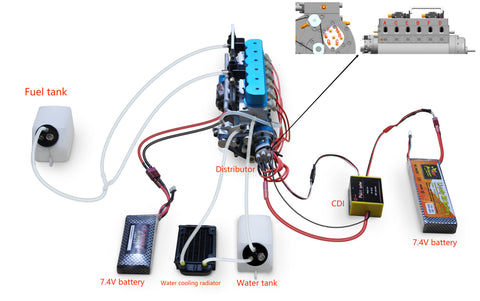
An inline-six engine, also known as a straight-six engine, is special because of its smooth and balanced power delivery. The inline configuration of the cylinders allows for even firing intervals, which results in a smooth-running engine with minimal vibration. Additionally, the long crankshaft of an inline-six engine helps to balance out the forces generated by the cylinders, further contributing to its smooth operation. Inline six engines are also known for their durability and longevity, making them a popular choice for use in heavy-duty applications such as trucks and larger vehicles.

It can be challenging to make a scale model of an inline-six engine, as it requires a high level of precision and attention to detail. The difficulty level depends on the level of detail and accuracy desired in the finished model. Building a scale model of an engine typically involves creating a detailed replica of all the internal components, such as the cylinders, pistons, and crankshaft, as well as the external components like the valve covers, oil pan, and intake manifold.



Creating a model of an inline-six engine specifically would require six cylinders, which are aligned in one line and connected to a crankshaft which could be difficult to construct as it will require more detailed and precise parts. Additionally, the model would need to be built to a specific scale, which can be difficult to achieve when working with small parts and tight tolerances. The most difficult part is the precision machining of the components. As the scale is miniature, the parts must be machined to exact specifications, as even small differences can have a huge impact on the operation of the model engine. Additionally, as the model is miniature, many of the parts will be difficult to produce and require skilled machinists and special tools in order to create them.
HOWIN ENGINE



Design and Manufacturing Process of Straight 6 Crankshaft
Inline six-cylinder engines have certain advantages in model cars due to the demand for low-speed torque. As engine development progresses, purely high-speed and low-speed torque with appropriate torque have become the watershed and design direction of engine design. To meet these requirements, increasing the crank stroke and end piston speed and improving durability are important considerations for in-line six-cylinder engines in passenger cars.
Straight 6 crankshafts are typically divided into two types: seven main journals fully supported crankshafts and four main journal non-fully supported crankshafts. However, this classification is not strictly scientific, as the six gaps in the middle of the 7 main journals distribute the 6 connecting rod journals at different angles. This design is difficult to machine due to the challenges of cam strength, crankshaft machining, and tile clearance.
At high engine speeds, the lack of torsional stiffness makes the crankshaft of the seven main bearing design more susceptible to torsion and potential fracture. Additionally, the camshaft of straight six engines is relatively long, which can lead to inaccurate valve timing of the cylinder farthest from the cam drive due to torsional and bending forces.
Crankshafts are mainly produced through the methods of forging, casting, and CNC numerical control machining. Early crankshafts were mainly cast, with molds made into the shape of the crankshaft, and molten steel poured into the mold and left to cool. This method of "gravity casting" can lead to casting trachoma due to air bubbles in molten steel. More advanced casting methods, such as special pressure casting, have been developed to address this issue.
Forging is still the most common method of crankshaft production, which involves a solid billet being heated to red heat and placed in a die for forging. The material is compressed to make the internal metallographic structure denser, resulting in a crankshaft with greater strength than cast parts. When making cross crankshafts for 5-cylinder, 6-cylinder, or V8 engines, twist forging is often used, which involves the crankshafts being aligned and forming the angle of the connecting rod through twisting. This process can be damaging to the internal grain structure, making the subsequent heating, heat preservation, and heat treatment processes difficult.
After rough machining, a rolling wheel is used to process a round of tamping, and the groove is heat-treated to ensure the allowance for subsequent grinding of the waist and belly and to remove the stress on the edge of the journal, and increase the strength. Advances in machining technology, which matured about 10 years ago, have enabled the inline six-cylinder to shine today.
The most difficult part of producing a miniature scale inline six engine model is achieving the correct size and scale of the components. It is a challenging task to create a model that is both accurate in its proportions and able to run reliably and consistently. Additionally, many of the parts and components necessary to build a scale model are not available in miniature sizes and must be custom designed and manufactured.
The first step in building a scale model of an inline six engine is to gather as much information about the engine as possible. This includes detailed drawings and specifications, as well as photographs and videos of the engine in operation. This information will be used to create accurate templates and patterns for the various parts of the engine. To begin, the size and scale of the model must be determined. This is typically done by starting with a full-scale engine and measuring its components. The measurements are then scaled down to the desired size of the model engine. As the size of the model is reduced, the proportion of the components must be maintained. This means that the pistons, cylinders, connecting rods, and other parts must be similarly scaled down.

photo from purplewave.com
Once the size and scale of the model have been determined, the parts and components must be sourced or custom-made. This can be a difficult and time-consuming process. Components such as pistons, cylinders, connecting rods, valves, and other parts are not typically available in miniature sizes. This means that custom parts must be designed, machined, and manufactured. Additionally, custom electronic components and wiring may be necessary to create a model inline six engine because it allows for more precise control over the engine's performance. This could include controlling the fuel injection system, ignition timing, and boost levels. It also allows for the engine to be tuned for specific performance requirements. Additionally, the wiring can help protect the engine from damage due to short circuits or other electrical faults.
Once the blueprint has been created, the machinist can begin to cut and shape the components. This typically involves the use of a variety of tools, such as milling machines, lathes, and grinders. The machinist must be careful to ensure that all of the parts will fit together properly and that the tolerances are met.
The next step is to finish the components. This includes polishing and sanding the parts to give them a smooth surface and a nice finish.
The next step is to begin the actual assembly of the model. This will involve carefully measuring and cutting the various parts to the correct size, then drilling and tapping any necessary holes. The parts will then be assembled using the fasteners and adhesives. It's important to take care when assembling the model, as mistakes at this stage can be difficult to correct.




Once the model is fully assembled, it will need to be painted and finished to achieve the desired level of detail and accuracy. This can be a time-consuming process, but it is crucial to achieving a finished product that looks as close to the real engine as possible. Because the engine is so small, even small variations in the parts can cause significant problems once the engine is assembled. The machinist must pay close attention to the tolerances necessary to create parts that fit and function properly. That's why producing a miniature scale inline six engine model is a complex and time-consuming process. It requires a great deal of precision and attention to detail in order to achieve a satisfactory result. The machinist must also be able to adjust and adjust the parts to ensure a proper fit. This requires a high level of skill and experience in order to be successful.

However, with the right tools, resources, and a clear understanding of the process, it is possible to create a high-quality, accurate scale model of an inline-six engine from scratch. It can be a time-consuming task, but the end result can be a rewarding and impressive howin engine model.

Overall, creating a scale model of an inline-six engine is a task that requires a high level of skill and patience, and is best suited for experienced model builders or those with a strong mechanical background.



For so many years, it is rare to see someone successfully make a straight six-six cylinder miniature engine model because they are bulky, heavy, and more expensive to manufacture. Firstly, the cost of production is higher due to the additional cylinders and components required for an inline six engine. Additionally, inline six engines require more space in the engine bay, making them less suitable for smaller scale models. So making an inline six engine model is still a thing in people's mind as it shows the old time that passed.. But now everything is changed. Howin team make your dream come true. That is HOWIN L6-210 engine, an affordable straight six cylinder howin engine that works. All you need to do is to start your engine building journey.
Book your HOWIN L6-210 from Stirlingkit. Howin Miniature inline six scale engines are designed for hobbyists who model and construct replicas of cars, boats, and other vehicles. There are 6 reasons why you should pick a Howin scale inline six scale engine.

1. Howin L6-210 can provide a realistic experience of the engine's performance, sound, and look. They are usually constructed to be a fraction of the size of a real engine F300, allowing it to be used in smaller-scale model airplanes and cars, and can provide the user with a realistic and enjoyable experience.
2. Additionally, these small scale engines offer a variety of features, such as adjustable RPMs and throttle control, that can provide a more realistic experience.
3. It can be used for display as a collectible item, because they provide a more realistic look and feel to their model projects. The Howin L6-210 engines are designed to look and sound as close to a real engine F300 as possible, while being small enough to fit in the model. This gives modelers the opportunity to create a more authentic representation of a RC vehicle.
4. Howin L6-210 can be a great way to teach the basics of engines and mechanics to younger users who may not be ready for a full-sized engine.
5. Howin L6-210 are easy to assemble and maintain. The parts are small and easy to work with, and the instructions are simple and straightforward. This makes the L6 engines ideal for hobbyists who are just starting out with model building.
6. Finally, Howin miniature inline six scale engines are relatively inexpensive. This allows hobbyists to experiment with different engine configurations and sizes without breaking the bank.
Other Questions You Might Want to Know
1. does crankshaft of the inline six engine easy to break?
No, the crankshaft of an inline six engine is typically very durable and not prone to breaking. The crankshaft is designed to withstand a great deal of stress, and is typically made of very strong materials such as steel or cast iron.
2. A turbocharger is not generally recommended for an inline six-cylinder engine.why?
Turbochargers are typically used on smaller engines due to their inherently lower displacement. An inline six-cylinder engine is relatively large and produces a lot of power, so it is not necessary to add a turbocharger to increase its performance. Furthermore, the complexity of installing a turbocharger on an inline six-cylinder engine makes it an impractical choice.







0 comments